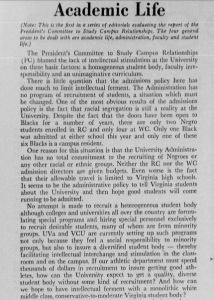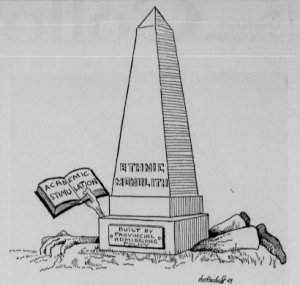This cartoon accompanied an editorial published on October 17, 1969, concerning academic life at the university. The editorial was part of a series from The Collegian that analyzed the results of the President’s Committee to Study Campus Relationships. The push for the study came from an earlier series of editorials published in 1968, which argued that distrust between the administration, faculty, and students fostered a negative environment at the school. Following the recommendation of the editorial series, President Modlin appointed a committee, comprised of both faculty and students, to study the problem in 1968. Modlin’s steadfast response to the students in the form of a committee cannot be considered outside of the context of what was going on around the United States at the time. In 1968 cities across the United States were engulfed in flames and rioting in response to Martin Luther King’s assassination, college campuses were sites of disruptive protests against the Vietnam War and the resulting draft, and even here in Virginia, the fight for integrated public schools was still being waged. While it is possible the Modlin simply acted out of goodwill and concern for students it is equally possible that he just wanted to keep the peace on campus by any means necessary. By allowing the study to happen but not actually do anything about it Modlin gave the appearance of a commitment to progress without actually being committed to progress.
 In part, the report from the study attributed low morale on campus to a lack of intellectual stimulation, which was reportedly caused by three factors: a homogenous student body, faculty irresponsibility, and unimaginative curriculum. The cartoon depicts the concern about homogeneity in the student body with a statue engraved with the words “ethnic monolith.” Said statue also carries an inscription that reads “built by provincial admissions policy”, which points to the fact that little money was dedicated to academic recruiting and little recruiting was done outside of Virginia at the time. According to the editorialist, the lack of diversity at the university was intellectually stifling. While I do see the merit of this piece in urging for diversity, the editorialist’s argument is very self-serving. In this appeal for more diversity, especially in regards to black students, there is little discussion of championing civil rights or combatting injustice. This editorial frames integration as good for white students and not necessarily a remedy for the injustices suffered by students from other groups. On a surface level what seems like an altruistic plea for integration is actually harmfully myopic. Instead of proposing to create an environment conducive to the success of students from different backgrounds the assumption is that simply having them at the university will make things better. Although well meaning, the argument in the editorial and the accompanying cartoon is negligent and misguided at best.
In part, the report from the study attributed low morale on campus to a lack of intellectual stimulation, which was reportedly caused by three factors: a homogenous student body, faculty irresponsibility, and unimaginative curriculum. The cartoon depicts the concern about homogeneity in the student body with a statue engraved with the words “ethnic monolith.” Said statue also carries an inscription that reads “built by provincial admissions policy”, which points to the fact that little money was dedicated to academic recruiting and little recruiting was done outside of Virginia at the time. According to the editorialist, the lack of diversity at the university was intellectually stifling. While I do see the merit of this piece in urging for diversity, the editorialist’s argument is very self-serving. In this appeal for more diversity, especially in regards to black students, there is little discussion of championing civil rights or combatting injustice. This editorial frames integration as good for white students and not necessarily a remedy for the injustices suffered by students from other groups. On a surface level what seems like an altruistic plea for integration is actually harmfully myopic. Instead of proposing to create an environment conducive to the success of students from different backgrounds the assumption is that simply having them at the university will make things better. Although well meaning, the argument in the editorial and the accompanying cartoon is negligent and misguided at best.

